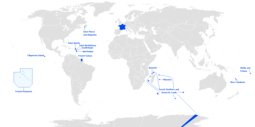French Dahomey
Colony of Dahomey and Dependencies Colonie du Dahomey et dépendances | |||||||||
|---|---|---|---|---|---|---|---|---|---|
| 1894–1958 | |||||||||
 | |||||||||
| Anthem: La Marseillaise | |||||||||
 Dark green: French Dahomey Lime: Rest of French West Africa Dark gray: Other French possessions Darkest gray: French Republic | |||||||||
| Status | French colony | ||||||||
| Capital | Porto-Novo | ||||||||
| Common languages | French (official) Bariba, Fon, Yoruba | ||||||||
| History | |||||||||
• Colonised | 1872 | ||||||||
• French West Africa | 1894 | ||||||||
• French Union | 4 September 1947 | ||||||||
• French Community | 4 December 1958 | ||||||||
| 1 August 1960 | |||||||||
| Currency | French West African franc CFA franc | ||||||||
| |||||||||
| Today part of | Benin | ||||||||
French Dahomey was a French colony and part of French West Africa from 1894 to 1958.[1] After World War II, by the establishment of the French Fourth Republic in 1947, Dahomey became part of the French Union with an increased autonomy. On 4 October 1958 the French Fifth Republic was established and the French Union became the French Community. The colony became the self-governing Republic of Dahomey within the Community, and two years later on 1 August 1960, it gained full independence (and changed its name to Benin in 1975).
| History of Benin |
|---|
 |
| History of the Kingdom of Dahomey |
| Early history |
|
| Modern period |
|
|
History[]
- Kingdom of Dahomey
This section's factual accuracy is disputed. (June 2019) |
During the 13th century, the indigenous Yoruba people of the west Niger area were run by a group of local chieftains,[2] but by the 17th century a single ruler known as the 'oba' had asserted control, creating the Kingdom of Dahomey. Under the dynasty established by Ewuare the Great[citation needed], the most famous of the obas, Dahomey's territory expanded to cover a region between the Niger River delta and what is now the Nigerian city of Lagos. The obas brought great prosperity and a highly organized state to Benin. They also established good relations and an extensive slave trade with the Portuguese and Dutch who arrived from the 15th century onwards.
The decline of the obas began in the 18th century when a series of internal power struggles began which lasted into the 19th century.
- Colony
The French takeover and colonization of the Kingdom of Dahomey began in 1872. The First Franco-Dahomean War in 1890 further weakened it. The Second Franco-Dahomean War resulted in it becoming a French protectorate in 1894.[3]
A decree dated 22 June 1894 created the Colonie du Dahomey et dépendances (Colony of Dahomey and Dependencies), which was to be incorporated into French West Africa in 1904.[2]
Under the French, a port was constructed at Cotonou, and railroads were built. School facilities were expanded by Roman Catholic missions. In 1946, Dahomey became an overseas territory with its own parliament and representation in the French national assembly.[4]
On 4 December 1958, it became the Republic of Dahomey (République du Dahomey), self-governing within the French Union.
- Independence
On 1 August 1960, the Republic of Dahomey gained full independence from France.
The republic's first president was Hubert Maga, who had been the Prime Minister during the overseas territory's last year under French rule.[5]
See also[]
- List of the colonial governors of French Dahomey
- Kingdom of Dahomey (1600−1904)
- French West Africa
References[]
- ^ Mills, Ian (13 September 2017). "French Colonies - Benin (formerly Dahomey)". www.discoverfrance.net. Retrieved 13 September 2017.
- ^ a b "HISTORY OF THE REPUBLIC OF BENIN". www.historyworld.net. Retrieved 13 September 2017.
- ^ "French Colonial Conquest of Dahomey in 1892 | HistoryNet". www.historynet.com. 5 September 2006. Retrieved 13 September 2017.
- ^ "The History of the Kingdom of Dahomey - Black History Month 2017". Black History Month 2017. Retrieved 13 September 2017.
- ^ kästle, klaus. "History of Benin (formerly Dahomey)". www.nationsonline.org. Retrieved 13 September 2017.
Further reading[]
- Chafer, Tony (2002). The End of Empire in French West Africa: France's Successful Decolonization. Berg. ISBN 1-85973-557-6.
- Dahomey
- History of Benin
- French West Africa
- Former colonies in Africa
- Former French colonies
- French colonisation in Africa
- States and territories established in 1904
- States and territories disestablished in 1958
- 1904 establishments in French West Africa
- 1958 disestablishments in French West Africa
- 1904 establishments in Africa
- 1958 disestablishments in Africa
- 1904 establishments in the French colonial empire
- 1958 disestablishments in the French colonial empire
- 1950s in the Republic of Dahomey
- Former polities of the Cold War

